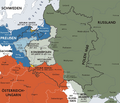Territorial evolution of the Ottoman Empire
This article's factual accuracy is disputed. (September 2016) |
The territorial evolution of the Ottoman Empire spans seven centuries.
Territorial evolution of the Ottoman Empire
The origins of the Ottomans can be traced back to the late 11th century when a few small Muslim emirates of Turkic origins and nomadic nature—called
While the Byzantine Empire was to continue for nearly another four centuries, and the
Among those principalities was a tribe called
1389

1481
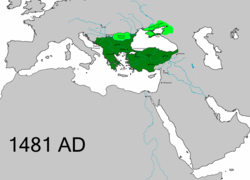
Mehmet II (
1520]
Selim I (
Selim's father was Bayezid II and his mother was
Selim carried the empire to the leadership of the
1566

Suleiman I (

1622

The
1672

In 1672 the Ottomans under Sultan Mehmed IV and Grand Vizier Fadil Ahmad Pasha conquered Podolia from the Polish–Lithuanian Commonwealth.
1683
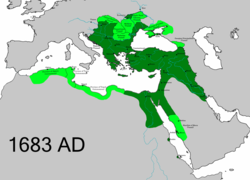
The
1699

The Treaty (Peace) of Karlowitz (Karlovci) was signed on January 26, 1699 in
Following a two-month congress between the Ottoman Empire on one side and the Holy League of 1684, a coalition of various European powers including the Habsburg Monarchy, the Polish–Lithuanian Commonwealth, the Republic of Venice and Peter I's Alekseyevich (later known as The Great) Muscovite Russia, largely due to claims of being a self-professed defender of the Christian Slavs, a treaty was signed on January 26, 1699. The Ottomans ceded most of Hungary, Transylvania and Slavonia to Austria while Podolia returned to Poland. Most of Dalmatia passed to Venice, along with the Morea (the
1718

The
During the years 1714–1718, the Ottomans had been successful against Venice in Greece and Crete, but had been defeated at Petrovaradin (1716) by the Austrian troops of Prince Eugene of Savoy.
The treaty reflected the military situation. The Ottoman Empire lost the
1739
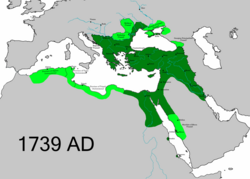
- The Treaty of Belgrade (Russian: Белградский мир) was the peace treaty signed on September 18, 1739 in Russo-Turkish War, 1735-1739 with the Treaty of Nissa, whereby it was allowed to build a port at Azov, gaining a foothold on the Black Sea.[9]
- The Treaty of Niš is a peace treaty signed on October 3, 1739 in Ottoman millet), a position also claimed by Russia. The Austrian pullout forced Russia to accept peace at Niš, giving up its claims to Crimea and Moldavia, being allowed to build a port at Azov but not to build fortifications there or have any fleet in the Black Sea.
-
Oltenia
1774
The
The treaty was by far the most humiliating blow to the once-mighty Ottoman realm. The Ottomans ceded the part of the
-
Crimean Khanate
-
Dnieper River
-
Southern Bug
The Ottomans also lost the Crimean Khanate, to which they were forced to grant independence. The Khanate, while nominally independent, was dependent on Russia and was formally annexed into the Russian Empire in 1783. The treaty also granted Russia several non-geographic items. It eliminated restrictions over Russian access to the Azov Sea (the 1739 Treaty of Belgrade had given Russia territory adjacent to the Azov Sea but had prohibited it from fortifying the area or using the sea for shipping.)
1792
The Treaty of Jassy, signed at Jassy (Iaşi) in Moldavia (presently in Romania), was a pact between the Russian and Ottoman Empires ending the Russo-Turkish War of 1787–92 and confirming Russia's increasing dominance in the Black Sea. The treaty was signed on January 9, 1792 by Grand Vizier Yusuf-Pasha and Prince Bezborodko (who had succeeded Prince Potemkin as the head of the Russian delegation when Potemkin died). The treaty recognized Russia's 1783 annexation of the Crimean Khanate and transferred Yedisan to Russia making the Dniester the Russo-Turkish frontier in Europe, and leaving the Asiatic frontier (Kuban River) to the East.
-
Yedisan or Jedisan on this map ceded to Russia
-
Asiatic frontier, or Kuban River Russian border to the East
1798
Led by
1801
The Turks struggle to hold onto Egypt against a civil war between the Albanians, Mamelukes, and Turks.
1812
The
-
Bessarabia
1817
| Rise of nationalism in the Balkans Nationalism under the Ottoman Empire |
|---|
|
The Second Serbian Uprising (1815–1817) was a second phase of the
1829

- The creation of a separate Great Powers in the London Protocol.
- The 1829 Treaty of Adrianople, without overturning Ottoman suzerainty, placed Wallachia and Moldavia under Russian military rule, awarding them the first common institutions and the semblance of a constitution. The Treaty of Adrianople also gave Russia most of the eastern shore of the Black Sea and the whole delta of or mouth of the Danube River. Turkey recognized Russian sovereignty over Georgia and parts of present-day Armenia.
1830
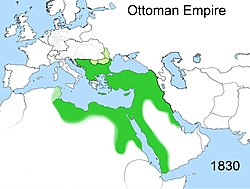
- Greece was recognized as a fully independent and sovereign kingdom in the London Protocol.
- During the Italian campaign of 1796. However, Bonaparte refused to pay the bill back, claiming it was excessive. In 1820, Louis XVIII paid back half of the Directory's debts. The Dey, who had loaned to the Bacri 250,000 francs, requested from France the rest of the money.
But another, more serious matter enraged the Dey. France had the commercial concession of a stockhouse in La Calle, and, by the intermediary of its representative Deval, had engaged itself not to fortify it. However, Paris did not respect its engagements. The Dey first requested explanations by sending a letter to the French government, who chose not to respond to him. Thus, the Dey orally asked the reasons behind this disrespect of their conventions to the French consul, who refused to respond to him.
The Dey responded to French disdain by hitting the consul Deval with his fan on April 30, 1827. This led to the rupture of diplomatic relations between France and the Dey, although the financial dealings between Deval and the Bacri-Busnach, as well as the Calle fortifications affairs were the real causes of the hostility.
Thereafter, the government of
The French troops took the advantage on June 19, during the battle of Staoueli, and entered in Algiers on July 5, 1830, after a three-week campaign. The Dey Hussein accepted capitulation in exchange of his freedom and the offer to retain possession of his personal wealth. Five days later, he exiled himself with his family, on board of a French ship heading for the Italian peninsula, then under the control of the Austrian Empire. 2,500 janissaries also quit the Algerian territories, heading for Asia, on July 11,. After 313 years of occupation, the Ottomans abandoned the Regency in Algiers and therefore the administration of the country, which they had taken care of since 1517.
1856
The Crimean War (1853–1856) was fought between Imperial Russia on one side and an alliance of France, the United Kingdom, the Kingdom of Sardinia, and the Ottoman Empire on the other. Most of the conflict took place on the Crimean Peninsula, with additional actions occurring in western Turkey, the Baltic Sea region and Kamchatka.
-
Territory restored to Turkey and Moldavia in 1856
1859
The electors in both Moldavia and Wallachia chose in 1859 the same person – Alexandru Ioan Cuza.
1862

On February 5, 1862 (January 24, Old Style) the two principalities of Moldavia and Wallachia were formally united to form Romania, with Bucharest as its capital.
1878

Ending the
The treaty recognized the complete independence of the principalities of
On the other hand, between 1840-1880 period; Ottoman vassal-Khedivate of Egypt and Ottoman troops conquered Soudan,some parts of Ethiophia, Eritrea and Northern Somalia. They co-administrated these places.

-
The Moldavian-Russian boundary in 1856/1857
-
Balkan changes from 1856 to 1878
-
Congress of Berlin
1881

- In the spring of 1881, the French army occupied Tunisia, claiming that Tunisian troops had crossed the border to Algeria, France's primary colony in Northern Africa. Italy, also interested in Tunisia, protested, but did not risk a war with France. On May 12, of that year, Tunisia was officially made a French protectorate with the signature of the Treaty of Bardo by Muhammad III as-Sadiq.
- In 1881 the Ottoman Empire ceded most of Arta Prefecture) to Greece.
- Soudan, Mehdi revolt; Ottoman vassal Khedivate of Egypt lost the control of Soudan.
- Political turbulence and financial problems in Khedivate of Egypt.
1882

With Egypt heading towards bankruptcy, the United Kingdom seized control of Egypt's government in 1882 to protect its financial interests, especially those in the
After that, Britain involved to Mehdis War in Soudan. In 3 years time, Ottoman Empire lost all co-administrated territories with Egypt in Africa such as North Somalia, Eritrea and Northern Ethiopia. The last only remnant Ottoman territory in Africa was "Ottoman Tripolitania."
1908
The
1912

The Italo-Turkish or Turco-Italian War (also known in Italy as guerra di Libia, "the Libyan war", and in Turkey as Trablusgarp Savaşı) was fought between the Ottoman Empire and Italy from September 29, 1911 to October 18, 1912. Italy seized the Ottoman provinces of Tripolitania and Cyrenaica, together forming what became known as Libya.There was no longer any Ottoman territory left in Africa. Following the First Balkan War, the Autonomous Principality of Samos, an Ottoman tributary state, was annexed to Greece in November 1912. See figure, right.
Italy also gained the primarily Greek-speaking
-
Dodecanese including Rhodes in 21st century Greece (prior to 2011, Dodecanese Prefecture)
1913

The Balkan Wars were two wars in Southeast Europe in 1912–1913 in the course of which the Balkan League (Bulgaria, Montenegro, Greece, and Serbia) first conquered Ottoman-held Macedonia, Albania and most of Thrace and then fell out over the division of the spoils. In the First Balkan War, the Ottomans lost practically all of their remaining territory in Europe, with the exception of Constantinople and its immediate environs. In the Second Balkan War, they recaptured some land to the north and west up to Adrianople (Edirne), comprising modern-day East Thrace.
After the Second Balkan War, the Ottomans were removed from Albania and there was a possibility of some of the lands being absorbed by Serbia and the southern tip by Greece. This decision angered the Italians, who did not want Serbia to have an extended coastline, and it also angered the Austro-Hungarians, who did not want a powerful Serbia on their southern border. Despite Serbian, Montenegrin, and Greek occupation forces on the ground, and under immense pressure from Austria-Hungary, it was decided that the country should not be divided but instead consolidated into the Principality of Albania. In the aftermath of the Balkan wars, Crete joined Greece on December 1, 1913.
Ibn Saud completed his conquest of the Nejd and the eastern coast of Arabia in 1912 and in 1913 took Al-Hasa from Ottomans who had controlled the area since 1871.
1914
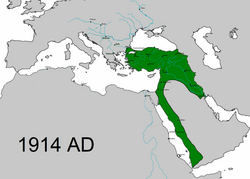
Following the Ottoman declaration of war on the Allies in November 1914, Britain formally annexed Cyprus, which it had occupied since 1878. Egypt (along with the Sudan) also finally ceased to be de jure Ottoman territory at the same time, being elevated to a
1920

The Treaty of Sèvres (August 10, 1920) was the
1923
The Treaty of Lausanne (July 24, 1923) was a
-
Treaty of Lausanne
See also
- Rise of the Ottoman Empire
- Timeline of the Ottoman Empire
- Administrative divisions of the Ottoman Empire
References
- ISBN 978-0-521-29135-4.
- ISBN 978-0-521-29163-7.
- ^ The Fall of Constantinople, Steven Runciman, Cambridge University Press, p.36
- ^ The Nature of the Early Ottoman State, Heath W. Lowry, 2003 SUNY Press, p.153
- ^ History of the Ottoman Empire and Modern Turkey, Stanford Jay Shaw, Cambridge University Press, p.24
- ^ Yavuz Sultan Selim Biography Retrieved 2007-09-16 Archived September 29, 2007, at the Wayback Machine
- ^ The Rise of the Turks and the Ottoman Empire Archived June 28, 2012, at the Wayback Machine Retrieved 2007-09-16
- ISBN 978-0-312-18708-8.
- ^ Henry Smith Williams (1909). The Historians' History of the World. Hooper and Jackson LTD. p. 410.
- ^ Ömer Lütfi Barkan (1985). Ord. Prof. Ömer Lütfi Barkan'a armağan. Istanbul University. p. 48.
- ^ The Times (London), 27. Idem., Jan 30, 1928, Editorial.
- ^ "Treaty of Lausanne - World War I Document Archive". wwi.lib.byu.edu. Retrieved March 9, 2022.
- S2CID 143692430.
- ISBN 9781610696883.
- ISBN 978-9004158825.
- ^ Treaty of Peace with Turkey signed at Lausanne, Lausanne, Switzerland, July 24, 1923, retrieved November 28, 2012
{{citation}}: CS1 maint: location missing publisher (link)






